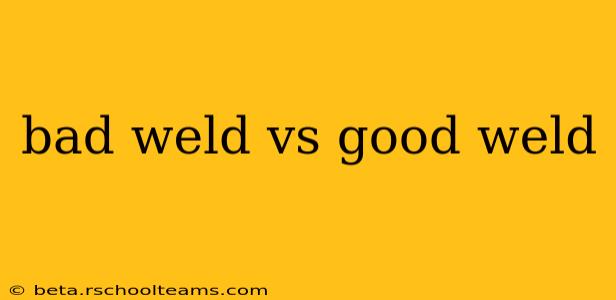Welding is a crucial process in numerous industries, from construction and manufacturing to automotive and aerospace. A successful weld ensures structural integrity and longevity. However, a bad weld can lead to catastrophic failures, posing significant safety and economic risks. This guide delves into the key differences between good and bad welds, focusing on visual inspection and understanding the root causes of defects.
What Makes a Good Weld?
A good weld is characterized by several key features:
- Complete Penetration: The weld should fully fuse the base materials, creating a solid, continuous bond throughout the entire joint. Incomplete penetration is a major weakness.
- Proper Fusion: The weld metal should seamlessly blend with the base metal, exhibiting a smooth transition without porosity or cracking. Lack of fusion is a common defect.
- Consistent Bead Appearance: A good weld typically has a uniform bead shape and size, free from excessive spatter or undercuts. The bead should be smooth and consistent along its length.
- Absence of Defects: A high-quality weld is free from defects such as cracks, porosity (small holes), slag inclusions (trapped impurities), undercut (grooves at the weld toe), and lack of fusion.
- Proper Mechanical Properties: The weld should possess the required strength, ductility, and toughness as specified by the application's requirements. These properties are often tested destructively or non-destructively.
What Constitutes a Bad Weld?
A bad weld exhibits one or more of the following characteristics:
- Incomplete Penetration: The weld doesn't fully join the base materials, leaving a gap or void. This significantly reduces the weld's strength and reliability.
- Lack of Fusion: The weld metal doesn't properly fuse with the base material, creating a weak point prone to failure. This often manifests as a lack of complete bonding between the weld metal and the base metal.
- Porosity: The presence of small holes (pores) within the weld indicates trapped gases during the welding process. These pores weaken the weld and can act as stress concentrators.
- Cracks: Cracks, whether surface or internal, represent a serious defect that drastically reduces the weld's strength and significantly compromises its integrity. They can initiate under stress and lead to catastrophic failure.
- Slag Inclusions: Trapped slag (impurities from the welding process) within the weld weakens the structure and compromises its overall quality. Slag inclusions can severely degrade the weld's mechanical properties.
- Undercuts: Grooves at the edges of the weld are called undercuts. These are undesirable because they create stress concentration points.
- Excessive Spatter: Although not always indicative of a structurally weak weld, excessive spatter suggests poor welding technique and can create surface imperfections.
- Incorrect Weld Profile: Deviation from the specified weld geometry (e.g., bead width, height, and reinforcement) signifies improper welding parameters or technique.
H2: How Can I Tell if a Weld is Bad?
Visual inspection is often the first step in identifying a bad weld. Look for the defects mentioned above: incomplete penetration, lack of fusion, porosity, cracks, slag inclusions, undercuts, excessive spatter, and an incorrect weld profile. However, visual inspection alone might not be sufficient to detect internal defects. Advanced techniques like radiographic testing (RT), ultrasonic testing (UT), and magnetic particle testing (MT) are employed for comprehensive evaluation.
H2: What Causes Bad Welds?
Several factors contribute to poor weld quality:
- Improper Welding Techniques: Incorrect welding parameters (current, voltage, travel speed) and poor operator skill can lead to various weld defects.
- Contaminated Materials: Dirt, grease, oil, or moisture on the base metal can hinder proper fusion.
- Insufficient Preheating: Some materials require preheating to prevent cracking or other defects.
- Incorrect Joint Design: A poorly designed joint can make it difficult to achieve a sound weld.
- Incorrect Welding Equipment: Faulty equipment, such as a malfunctioning welding machine or inadequate shielding gas flow, can also result in bad welds.
H2: How to Prevent Bad Welds?
Preventing bad welds involves a multifaceted approach:
- Proper Weld Preparation: Clean the base material thoroughly and ensure proper joint design.
- Qualified Welders: Employ skilled and certified welders who are proficient in the chosen welding process.
- Regular Equipment Maintenance: Ensure that all welding equipment is properly maintained and calibrated.
- Quality Control: Implement rigorous quality control measures, including visual inspection and non-destructive testing.
- Adherence to Welding Procedures: Follow established welding procedures and specifications meticulously.
By understanding the characteristics of good and bad welds, implementing proper welding techniques, and employing thorough quality control measures, it's possible to minimize the occurrence of weld defects and ensure the safety and reliability of welded structures. Remember that safety should always be the paramount concern in any welding application.
